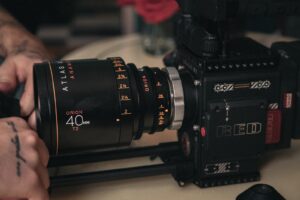
Anamorphic lenses are specialized optical tools used in filmmaking and photography to achieve a distinctive widescreen cinematic look. These lenses squeeze a wider field of view onto the camera’s sensor, creating an elongated and often distorted image. The key feature of anamorphic lenses is their ability to create a unique aspect ratio, commonly 2.35:1 or 2.39:1, which produces the classic widescreen cinematic effect seen in many movies. When used correctly, anamorphic lenses can produce breathtaking lens flares, unique bokeh, and a distinctive sense of depth, adding a cinematic quality to the visuals.
The Blackmagic Pocket Cinema Camera (BMPCC) is a popular choice among independent filmmakers and enthusiasts for its outstanding image quality and affordability. When paired with anamorphic lenses, the BMPCC allows filmmakers to capture stunning, cinematic footage with the characteristic anamorphic qualities, making it an excellent choice for those looking to achieve a professional and visually striking look in their projects. However, using anamorphic lenses with the BMPCC requires a good understanding of the lenses, camera settings, and post-production processes to fully harness their potential and create visually captivating content.
Using anamorphic lenses with the Blackmagic Pocket Cinema Camera (BMPCC) can be a great way to achieve a unique cinematic look. Anamorphic lenses are known for their ability to produce a widescreen, cinematic aspect ratio and create distinctive lens flares and bokeh.
Anamorphic lenses, when paired with the Blackmagic Pocket Cinema Camera, unlock a cinematic world of distinctive widescreen visuals, lens flares, and unparalleled storytelling potential, elevating your filmmaking to a professional level.
Here are some considerations and steps to use anamorphic lenses with the Blackmagic Pocket Cinema Camera:
- Understanding Anamorphic Lenses: Anamorphic lenses squeeze a wider field of view onto the camera’s sensor, creating a distorted image. This squeezed image needs to be “de-squeezed” or “de-squeezed” in post-production to restore the correct aspect ratio.
- Lens Compatibility: Ensure that the anamorphic lens you choose is compatible with the BMPCC. Some lenses may require adapters or modifications to work correctly. Consult the lens manufacturer’s documentation or online resources for compatibility information.
- Mounting the Lens: Mount the anamorphic lens onto your BMPCC using the appropriate lens mount or adapter if necessary. Make sure the lens is securely attached to the camera.
- Aspect Ratio Setting: Configure the BMPCC to the correct aspect ratio for your anamorphic lens. Common anamorphic ratios include 2.35:1 or 2.39:1. Adjust the camera’s settings accordingly.
- Monitor Setup: Use an external monitor or EVF that supports the chosen aspect ratio to frame your shots accurately. This helps you compose shots correctly and avoid any surprises during post-production.
- De-Squeezing in Post-Production: During post-production, you’ll need to de-squeeze the footage to restore the correct aspect ratio. Most video editing software applications offer tools or plugins for de-squeezing anamorphic footage. Be sure to follow the specific instructions for your editing software.
- Lens Flares and Bokeh: Anamorphic lenses are known for their unique lens flares and bokeh. Embrace these characteristics to create a distinctive visual style. Experiment with lighting angles to enhance lens flares creatively.
- Focus and Depth of Field: Anamorphic lenses can affect the depth of field and focus. Pay close attention to focusing, as the squeeze factor can make it challenging to achieve sharp focus, especially at wider apertures.
- Stabilization: Anamorphic lenses can be heavier and bulkier than standard lenses. Consider using a tripod or stabilizer to maintain stable shots, especially when shooting handheld.
- Practice and Experiment:Anamorphic shooting requires practice to master. Experiment with different settings, lighting conditions, and lenses to find the look that suits your project.
Remember that using anamorphic lenses can be more involved than shooting with standard lenses, but the unique visual characteristics they offer can be rewarding for filmmakers looking to achieve a cinematic and distinctive look. Be patient, practice, and refine your skills to make the most of anamorphic lenses with your Blackmagic Pocket Cinema Camera.











